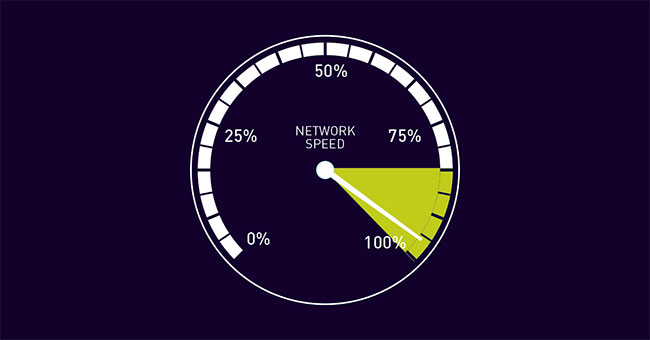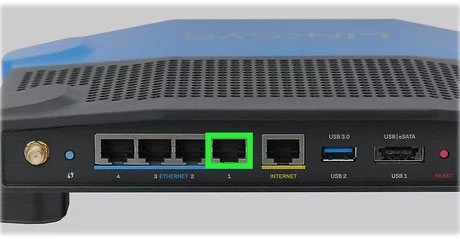Difference between port speed and modem speed
Both speeds can act as performance limiting factors, potentially slowing down internal and external traffic. Knowing how to measure these speeds and their impact can help you identify poorly performing routers on your business network.
Network speed

Network speeds are measured in bits per second (bps). Bps is a measure of how many binary numbers can be transmitted between two points on the network in one second, with one bps equal to a binary number transmitted. It is important to avoid confusing data rate with bandwidth when measuring network speed. Bandwidth is a measure of the amount of data that can be transferred at the same time, while data rate is a measure of the speed of data transmission.
Port speed
Wired routers often use Ethernet interfaces to communicate with devices on the local network. The port speed is a measure of the speed of transmitting and receiving data of these interfaces. It is mainly determined by two factors: the version of Ethernet used by the port and the baud rate used by the clients with which it is communicating. Devices that use the newer Ethernet standards, such as Gigabit Ethernet, can reduce their speed if they detect that they are communicating with a device using the slower Ethernet version.

Modem speed
Modem speed is a measure of the speed through the external interface a router uses to communicate with the modem, rather than its internal interface. This is important because modems use Wide Area Network (WAN) technology to allow the router to communicate with external clients, often slower than the local Ethernet connection. Therefore, the router's modem speed is likely to be significantly lower than its port speed, even if the router uses the same Ethernet version to communicate with the modem as with other network devices.
What does the difference between modem speed and port speed mean?
The difference between the modem speed and the port speed means that network traffic runs at different speeds depending on its origin and destination. For example, let's say you have 4 computers connected over a 1Gbps Ethernet connection with a router that uses a 50Mbps cable to connect to the Internet.
Traffic sent directly between computers will move at 1Gbps, but Internet traffic will move at 50Mbps. The slower communication over the router's modem interface acts effectively as a limit of speed for all outgoing traffic.
You should read it
- These factors determine the speed of the computer
- What is the difference between upload and download speed?
- 7 mistakes should be avoided when checking Wi-Fi speed
- How to speed up internet Win 10 thoroughly
- Measuring the speed of Viettel, VNPT and FPT using Speed Of Me
- Control computer fan speed
- Simple operations to speed up the Macbook
- 5 best Windows speed test applications on Windows
May be interested
- Check that the port port is open, the connection is being made in the system
 some basic steps to check which ports are open, connections being made to help you make sure what is happening with your internet speed.
some basic steps to check which ports are open, connections being made to help you make sure what is happening with your internet speed. - Restart the router and modem properly?
 restarting network devices in the correct steps can make a difference.
restarting network devices in the correct steps can make a difference. - 10 best combo cable modem / router today
 finally, with today's advanced technology, users can take advantage of high-speed internet service providers, along with high-performance wi-fi through 2-in-1 devices: cable modem router.
finally, with today's advanced technology, users can take advantage of high-speed internet service providers, along with high-performance wi-fi through 2-in-1 devices: cable modem router. - What is a modem? Functions of Modem
 what is a modem? this is a device that has the function of modulating and demodulating any traditional signal coming from the network into a digital signal that user devices can understand.
what is a modem? this is a device that has the function of modulating and demodulating any traditional signal coming from the network into a digital signal that user devices can understand. - What is AAA PC Port? Why do they have so many problems?
 big companies often make aaa games on consoles. however, when they port these games to pc (called porting process), they often run into a ton of problems.
big companies often make aaa games on consoles. however, when they port these games to pc (called porting process), they often run into a ton of problems. - What is the difference between upload and download speed?
 if you've ever conducted an internet speed test, chances are you've come across two distinct values: upload and download speeds.
if you've ever conducted an internet speed test, chances are you've come across two distinct values: upload and download speeds. - The difference between TCP and UDP protocols
 you may have seen tcp and udp when setting up port forwarding on the router or when configuring the firewall software. these two protocols are used for different data types.
you may have seen tcp and udp when setting up port forwarding on the router or when configuring the firewall software. these two protocols are used for different data types. - Common TP Link modem login addresses
 to change the password, or the wifi name for the tp link modem, users need to log in to the address for this modem line. so what is the tp link modem login address?
to change the password, or the wifi name for the tp link modem, users need to log in to the address for this modem line. so what is the tp link modem login address? - How to change LPT port in CMOS
 on older computers that use the lpt port to connect the software to the printer connected to the parallel port, follow these steps to configure the port in the system bios.
on older computers that use the lpt port to connect the software to the printer connected to the parallel port, follow these steps to configure the port in the system bios. - How to connect printer 2.0 USB port to USB 3.0 port on Windows 10
 the following article will guide you how to connect the usb 2.0 port of the printer to the usb 3.0 port on your computer. if you are having a similar problem, try it now!
the following article will guide you how to connect the usb 2.0 port of the printer to the usb 3.0 port on your computer. if you are having a similar problem, try it now!










 Review D-Link DIR-822: Cheap WiFi Router for Home
Review D-Link DIR-822: Cheap WiFi Router for Home How to install the Tether app to manage the Router on your phone
How to install the Tether app to manage the Router on your phone 4 best models of Mesh router for increasing WiFi wave 2020
4 best models of Mesh router for increasing WiFi wave 2020 How to fix Laptop not getting wired network
How to fix Laptop not getting wired network Use ExpressVPN on Apple TV
Use ExpressVPN on Apple TV Should use Dongle or portable WiFi transmitter?
Should use Dongle or portable WiFi transmitter?